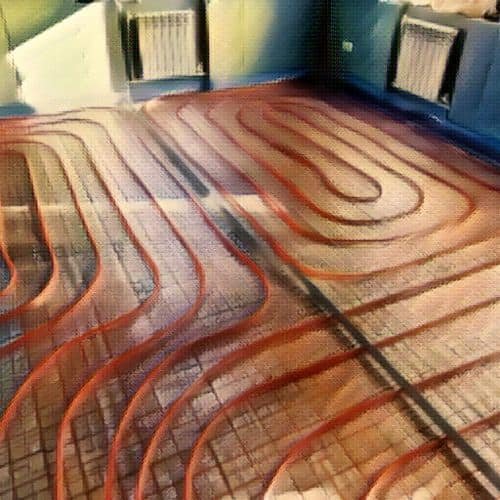Share This Guide
Heating a large space such as a large living space or a warehouse can be a bit challenging. You will need to carefully look at possible options and weigh the pros and cons of each of them.
The best way to heat a large space, in the long run, includes forced air systems and radiant floor heating systems. But for temporal or short-term heating, smaller and portable heaters such as space heaters will suffice.
But you need to keep in mind that finding the best way to heat a large space will also depend on a number of factors, including the size and layout of the space, and the budget available for heating. In general, the most common ways to heat large spaces include:
- Forced-air heating systems, use a network of ducts to distribute the heated air throughout the space.
- Radiant heating systems, use radiant heat to warm the space directly, without the need for ducts.
- Boilers, use heated water or steam to warm the space.
- Electric heaters, use electricity to generate heat in specific areas.
Additionally, it is always important to ensure that the space is well-insulated to prevent heat from escaping and to go for energy-efficient heating systems to minimize costs. It may be helpful to use a combination of heating methods, such as radiant floor heating and forced-air heating, to create a more comfortable and evenly heated space ( though this can be costly)
Challenges of heating a large space
Heating a large space such as a warehouse or a commercial building can be challenging for a few reasons. One of the main challenges is the sheer size of the space, which can make it difficult to heat evenly and efficiently.
Another challenge is the fact that these types of buildings often have high ceilings, which can cause heat to rise up quickly leaving colder air underneath, making it harder to maintain a consistent temperature throughout the space.
Additionally, large buildings often have a lot of windows and doors, which can also make it difficult to maintain a consistent temperature by letting heat escape.
On top of that, heating a large space can be expensive, particularly if the building is not well-insulated or if it is located in a region with extremely low temperatures.
Best way to heat a large living room

The best way to heat a large living space will depend on a number of factors, including the size and layout of the space. But some common ways to heat large living spaces include:
| Method of heating | Example |
| Forced-air heating systems | Furnace or heat pump |
| Radiant floor heating system | Underfloor water piping or electrical coils |
| Boilers | Hot water in a network of pipes |
| Electric heaters | Space heaters |
- Forced-air heating systems can be the best solution for new construction or home renovation
- A radiant floor heating system is a newer trend of heating and is suitable for the initial construction of a home or during a renovation.
- Boilers are common in older homes.
- Electric heaters are a great temporal solution.
Best way to heat a large garage

There are several ways to heat a large garage and some options to consider include: (from least to most effective)
Space Heaters
Space heaters are a portable and affordable option for heating small areas of a large garage. Depending on the area to heat, you might need to place many units to adequately heat your entire garage.
Space heaters were created to warm a single room or tiny area, so they might not be effective at heating a big garage on their own. Nonetheless, they can be utilized to supplement other heating resources or to provide targeted heat to certain locations of the garage.
To make use of a space heater to heat a huge garage, you’ll need to choose a heating system with enough power to heat up the area. Heaters are rated by their BTU (British Thermal Unit) result, which shows the amount of heat they can produce. For a huge garage, you’ll likely need a heating unit with a high BTU outcome, such as 10,000 BTUs or even more. Such as the Mr. Heater unit below…
- POWERFUL HEATING: This natural gas wall heater efficiently delivers powerful, sun-like warmth with a 10,000 BTU output covering spaces up to 300 sq. ft
- RADIANT VENT FREE GAS HEATER: Utilizes multiple burner tiles and its advanced infrared technology to harness radiant heat; warming the objects in the room to heat the air; ideal for providing supplemental heat in offices, garages, patios, & cabins
- SAFETY PROTECTION: This indoor gas heater features an automatic low-oxygen shut-off system; its sensor detects oxygen drops, instantly cutting gas to stop the heater; ensuring safe, reliable warmth for you and your family
- EASY TEMPERATURE CONTROL: This ventless natural gas heater features a multi-output valve for easy temperature regulation, ensuring consistent, safe heat; its battery-powered electronic ignition allows for quick, one-handed startup
- FLEXIBLE & EASY SETUP: This ventless gas heater offers versatile installation options to suit your space; it includes sturdy feet for secure floor placement and mounting hardware to hang on the wall so it can accommodate the needs of your space
To take full advantage of the effectiveness of a space heater in a big garage, you ought to additionally think about the following:
- Positioning: Put the heater in a central location or in an area where you’ll be spending a lot of your time, such as near a workbench or device storage space area.
- Insulation: Shield the garage to minimize heat loss and also enhance the effectiveness of the heater. This can consist of adding weatherstripping to doors and windows, sealing voids and splits in the wall surfaces and also the ceiling, and also including insulation to the wall surfaces as well as the attic.
- Ventilation: Appropriate ventilation is very important to make sure the safe and also efficient operation of a space heater. Keep windows and doors open up to permit fresh air to flow, and also ensure the heating system is positioned in a well-ventilated area.
- Timing: Make use of the heater only when you remain in the garage, and transform it off when you delegate conserve power, and lower the threat of a fire.
By following these tips, you can use a space heater to help heat a large garage, but it may still be necessary to supplement with other heating sources that I have listed below to fully heat the space.
Gas or Propane Heaters
Gas or propane heaters are a more powerful option than a space heater and can heat a larger garage more efficiently and also can operate independently of an electrical power source. They can be mounted on the wall or ceiling, and some models come with a thermostat to help you control the temperature.
Nevertheless, they do call for a reliable source of gas, such as a propane tank or gas line, as well as they may be extra expensive to operate than various other types of heating systems.
To utilize a gas or gas heating unit to warm a huge garage, you’ll need to choose a heater with sufficient power to heat the space. For a large garage, you’ll likely require a heating unit with a high BTU output, such as 30,000 BTUs or even more. This is one I have used in the past…
- Fight the freeze! Pick yours and order today! Mr. Heater Vent-Free Heater
- 30,000 BTU”
- Weighs 31 lbs.
- Safe, clean burning heat
- Operates without electricity during power outages
Forced Air Furnace
If your garage is attached to your home, you may be able to use the same furnace for the house to heat the garage as well. This can be an effective way to heat a large garage, as it can distribute heat evenly throughout the space and can be controlled with a thermostat.
To use a forced-air furnace to heat a large garage, you’ll need to connect your network of pipes or ducts to flow to the garage. Help from an HVAC tech may be required to install it properly.
Radiant Heaters
Electric radiant heaters are another option for heating a garage. They work by emitting infrared radiation, which warms objects and people in the room rather than the air itself. This can make them more efficient than other types of heaters.
To heat a large garage with a radiant heater, you would need to determine the size of the garage and the amount of heat needed to maintain a comfortable temperature.
One option would be to install multiple radiant heaters around the garage, spaced out in a way that will ensure even heating throughout the space. You could also consider installing a radiant heating system under the floor, which can be an efficient way to heat a large garage as it heats the entire floor evenly.
It’s important to consider the size of the radiant heaters you choose, as well as the power output and heating coverage of each unit. You may also want to consider installing a thermostat to help regulate the temperature and ensure that the garage stays at a comfortable level.
Infrared Heaters
Infrared heaters work by emitting infrared radiation, which is a type of electromagnetic radiation with a longer wavelength than visible light. This is absorbed by objects and surfaces in the garage, warming them up. These heaters are typically mounted on the ceiling or wall, and can be an efficient and cost-effective way to heat a large garage.
This patio heater has worked well for me in my shop.
- 【Powerful & Wide-use】 GreenVines 1500W infrared electric wall-mounted heater provides comfortable infrared heat in 3 sec that allows you to create a warm and welcoming atmosphere in your backyard, garage, porch, deck, garage, living rooms, bedrooms, as well as restaurants & commercial cafes. Enjoy a warm and beautiful day & night with your loved ones
- 【Durable & Superb】 Compared with typical patio heaters, our high-quality outdoor heater brings better performance for daily use. The high-strength and high-density aluminum with durable powder coating is waterproof (IP55), dustproof, rustproof & corrosion-resistant. The infrared heater uses a revolutionary carbon fiber golden tube to emit heat with no noise while producing no visible light from a slim enclosure
Best way to Heat a Warehouse

A warehouse is much larger than any of the spaces we have discussed above and some of the heating options mentioned cannot heat up a warehouse. A warehouse can effectively be heated by the following:
- Forced-air furnace: A forced-air furnace is a common choice for heating warehouses or any other commercial space. It works by heating air and distributing it throughout the space using a system of ducts and vents. This can be a cost-effective option, but it may not be as efficient in a large warehouse.
- Boiler: Though not so common nowadays, a boiler is another option for heating a warehouse or any other commercial space. It heats water, which is then distributed through a system of pipes and radiators to heat the space. This can be a more efficient option than a furnace, but it may be more expensive to install.
Pros and Cons of each heating option for a large space
Radiant Floor Heating (Pros And Cons)

Radiant floor heating, also known as underfloor heating, is a type of heating system that warms a room by heating the floor from below. This can provide a more even and comfortable heat than other systems, which heat the air directly. Some potential pros and cons of radiant floor heating include:
| Pros | Cons |
|---|---|
| Comfort: Radiant floor heating can provide a more comfortable and consistent heat, as it warms the objects and people in the room rather than just the air. | Cost: Radiant floor heating systems can be more expensive to install than traditional heating systems, as they require specialized equipment and expertise. |
| Energy efficiency: Radiant floor heating can be more energy efficient than other types of heating systems, as it can operate at lower temperatures and still provide a significant level of warmth. | Slower to heat: Radiant floor heating can take longer to heat a room than traditional systems, as it warms the floor and objects in the room rather than the air. |
| Quiet operation: Radiant floor heating systems are typically very quiet, as they don’t have any moving parts or fans. | Limited to certain floor types: Radiant floor heating systems are typically only suitable for certain types of flooring, such as tile, stone, or concrete. They may not be suitable for use with carpet or wood floors. |
| Hidden: Radiant floor heating systems are hidden beneath the floor, so they don’t take up any valuable space in the room. | May require professional installation: Radiant floor heating systems can be complex to install, and typically require the services of a trained professional. |
The pros and cons of radiant floor heating will depend on your specific needs and circumstances. It’s a good idea to weigh the potential benefits and drawbacks carefully before deciding whether radiant floor heating is the right option for you.
Space Heaters ( Pros And Cons)

Space heaters are portable heating units that are designed to heat single rooms.
They are a popular option for people who want to supplement their central heating system or provide heat to a small space. Some potential pros and cons of space heaters include:
| Pros | Cons |
|---|---|
| Affordability: Space heaters are typically more affordable than other types of heating systems. | High operating costs: While space heaters are affordable to purchase, they can be expensive to operate. Electric space heaters can be particularly costly to run, as they consume a lot of energy. |
| Portability: Space heaters are portable, so you can move them from room to room as needed. This can be especially useful if you only want to heat certain rooms in your home or office. | Inefficiency: Space heaters can be less efficient than other types of heating systems, as they heat the air directly and can cause heat to be lost through drafts and open doors and windows. |
| Fast heating: Space heaters can heat a room quickly, so you can turn them on and feel warm in a matter of minutes. But you might want to get multiple units to heat a larger space. |
Forced Air Heating System (Pros And Cons)

Forced air heating is a type of heating system that uses a furnace to heat air and distribute it throughout a building using a system of ducts and vents. This is a common type of heating system in many homes and buildings. Some potential pros and cons of forced air heating include:
| Pros | Cons |
|---|---|
| Efficiency: Forced air heating systems can be efficient, as they can heat a large area quickly and evenly. | Noise: Forced air heating systems can be noisy, as they use fans to distribute the heated air throughout the building. This can be disruptive, especially in quiet spaces. |
| Versatility: Forced air heating systems can be used with a variety of fuels, including natural gas, propane, and oil. This allows you to choose the best option for your needs and budget. | Drafts: Forced air heating systems can produce drafts, as the heated air is distributed through vents and ducts. This can make some rooms feel cold and drafty. |
| Air quality: Forced air heating systems can help to improve the air quality in a building, as they can be equipped with air filters and humidifiers to remove dust and allergens from the air. | Maintenance: Forced air heating systems require regular maintenance to ensure that they are operating efficiently and safely. This can include cleaning the air filters and ducts, as well as checking and replacing the furnace and other components as needed. |
Conclusion
When it comes to heating a large space such as a large living room, a forced-air furnace may be the best option. Forced-air furnaces are efficient at heating large areas quickly and evenly, and they can be easily integrated with the rest of the heating system in your home. They can also be equipped with air filters and humidifiers to improve the air quality in the room.
A radiant heating system may also be an excellent option. Radiant heating systems use infrared radiation to heat objects and people directly, rather than heating the air. This can make them more efficient in a large, open space like a warehouse, as the heat will not be lost through drafts and open doors and windows. They can also be installed in the floor or ceiling, which can save valuable space in the warehouse.

HVAC tech with over 30 years of experience. Retired and doing repair work on the side around Madison County, AL.

